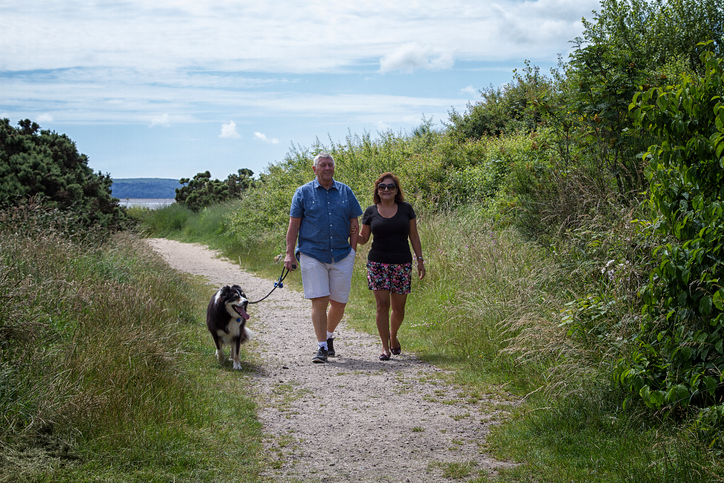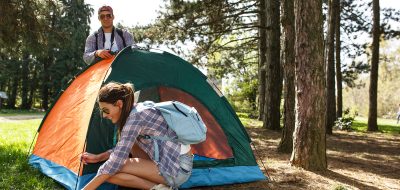
Heed this dog walking wisdom…
Like their human counterparts, dogs are eager to explore their new surroundings once the RV has reached its destination. But before putting the leash on your four-legged friend and hitting the trail, consider the following tips:
The right leash for dog walking
Prior to taking the first steps on the walk, make sure you’re using the proper leash. Retractable leashes are great for expansive areas with lots of room to explore. However, if you’re setting out on a narrow trail with deep underbrush and heavy foot and bicycle traffic, you’ll need to be able to keep your dog from wandering into danger. In that case, keep your dog on the proverbial “short leash.” (Fortunately, retractable leashes give you the option of keeping your dog in check).
Dog walking location, location, location
Be aware of the hazards and distractions that might stimulate your dog during the walk. Does your pooch dart after other dogs or people? If the answer is “yes,” try to avoid walking during high-traffic periods. You might also scout out a less-busy walking area. If your dog’s unruly walking behavior is a problem, consider training options (see below).
Dog walking this way
Always avoid allowing your dog to poke its snout into underbrush or exposed crevices under rocks; these habitats are homes to rattlesnakes and other dangerous critters. At the same time, avoid letting your dog get deep into the shrubbery or tall grass. During tick season, these little parasites like to perch at the ends of branches, just waiting for a free ride on your pet. Also, make sure your dog doesn’t venture into another RVer’s campsite. Not everybody loves dogs as much as you do!
Man-made dog walking hazards
Be careful when walking your dog on lawns. Pesticides and fertilizers can be toxic to dogs. Also, exercise caution around flowers. Some dogs have an appetite for tulips and other pretty blossoms that might be planted throughout the RV park—these can cause stomach problems for canines.
What to bring when dog walking
Regardless of the length of your walk, you should always pack plastic bags for waste—you never know when nature will call. Water is another essential—even on relatively short hikes, dogs can become dehydrated. Portable water bowls will make drinking convenient for your pooch. Last but not least, don’t forget dog treats—these will come in handy when you want to reinforce good behavior.
Train to win at dog walking
Consider enrolling your dog in a training class before hitting the trail. Training will address problems your dog might have when it comes to dealing with other dogs, strangers and wildlife. A well-trained dog means a happy human, and that will go a long way toward making your walk much more pleasurable.











Anonymous
You should also always have a copy of your dogs vaccine history, especially the Rabies Certificate. Should your dog bite someone or someone’s dog that will be required by the authorities and can save you a lot of head ache if the certificate is readily available.
Also when traveling across State lines a recent health certificate from the veterinarian stating your dog is in goog health while on vacation can also save you potentential headaches, especially if one runs into a ‘by the rules’ police officer.
Charles Hickey, DVM
Good Sam Camping
Try these:
https://blog.goodsam.com/keep-your-cat-happy
https://blog.goodsam.com/rving-with-a-cat
Anonymous
All great ideas. I would like information on
Kennels for animals near campgrounds, etc
Anonymous
Depending on where you walk you might want to take into consideration what kind of wildlife and loose dogs you might run into. Even a domestic cat can and have caused damage to leashed animals. In most parts of the world pepper spray is a sufficient deterrent for most hazards you might encounter. In some places Bear strength pepper spray may be called for. I have encountered dogs, cats, foxes, lynx and skunks that were aggressive.